Coolant temperature. Engine operating temperature - what is the optimal
It is a combined solution that combines liquid and air cooling. At the same time, the main task of the entire complex of devices is to maintain the operating temperature of the engine within strictly specified limits.
In other words, the motor temperature should not be too low or too high. In the first case, when the engine does not reach, efficiency suffers, the exhaust becomes toxic, power is lost, the resource decreases, etc. In the second, when , occurs, the engine can quickly fail or .
It becomes clear that the normal temperature of the coolant of a warm engine directly depends on the quality of the cooling system. Next, we will talk about what coolant temperature is the norm for a warmed-up power unit, and also why the indicated operating temperature may deviate from normal or optimal values.
What is the normal coolant temperature of a warm engine
As a rule, various serious failures and deviations in the operation of the cooling system are immediately recorded by the driver. If the engine does not warm up, then the stove does not work well in winter, the comfort of using the vehicle decreases.
If the engine overheats, this can be determined by the temperature gauge on the dashboard; on many cars, an emergency sound signal, steam may simply come out from under the hood, etc.
In such situations, the problem is obvious, problems are easier to localize and fix. However, more difficult situation is such when the engine warms up, but not completely, and the internal combustion engine can also overheat, but only partially. Quite often, drivers also note significant fluctuations in coolant temperature for no apparent reason.
Anyway, but this problem need to be eliminated, since breakdowns in the cooling system tend to progress, and quickly enough. Such deviations from the norm, even minor ones, also do not add a resource to the engine.
First of all, you need to understand that for most engines, the optimal temperature range for a warm engine (when the engine has fully reached operating temperature) is from 80 to 90 degrees Celsius. This is the normal temperature of the coolant on a warm engine.
Also note that the working fluid in the cooling system is antifreeze or antifreeze (only water has not been used on modern and other cars for a long time). The specified antifreeze/antifreeze is a mixture of concentrate and distilled water. Antifreezes have anti-corrosion and lubricating properties.
A mixture of concentrate and water usually freezes at temperatures around -40 and below (depending on the proportions), and boiling occurs when heated from 108 degrees Celsius. At the same time, on most cars, the temperature sensor will show overheating when the coolant temperature reaches about 100 degrees Celsius.
Also, as mentioned above, the engine may not reach operating temperature, that is, it may remain cold all the time or not warm up enough. The consequences are not as terrible as overheating, but the malfunction still needs to be fixed. To deal with possible reasons, attention should be paid to the features of the cooling system and temperature control.
How the cooling system keeps the temperature within the specified limits
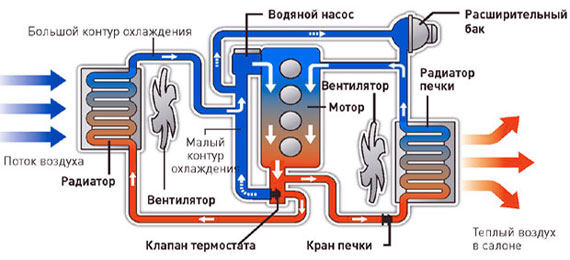
To begin with, after starting a cold engine, it forces the coolant to circulate through the channels of the cooling system. In this case, the channels can be divided into a large and a small circle.
Small circle - circulation occurs inside the cylinder block and cylinder head. Large circle - liquid enters. Responsible for the opening of a large circle, which is completely closed in the cold. As the liquid heats up, the thermostat begins to open, after which the antifreeze or antifreeze enters a large circle.
By the time the liquid warms up to 80-90 degrees, the thermostat will be fully open and the liquid will begin to circulate only in a large circle. After the temperature drops, the thermostat will partially or completely close. In a nutshell, this is the scheme for regulating the operating temperature of the engine and coolant.
Installed in parallel on the engine. This sensor, if necessary, activates air cooling, sending a signal to turn on.
As for the properties of the coolant, boiling under atmospheric pressure begins at 108-110 degrees. However, before boiling begins, vapor locks begin to form in the system, which disrupt the operation of the internal combustion engine cooling system. As a result, the motor may overheat.
Summing up
As you can see, the operating temperature of the coolant on a warm engine should not be above or below the average mark of 80-90 degrees. More accurate information can be obtained by examining the manual for a particular car.
The fact is that modern ones are distinguished by an extremely high thermostating temperature, which also needs to be taken into account separately. You also need to remember that on many cars the temperature gauge on the instrument panel displays somewhat averaged indicators.
In order to know exactly what the heating of the coolant and the motor is under certain conditions, it is recommended to install a separate one. Note that the cooling system necessarily needs regular maintenance. Antifreeze or antifreeze must be changed in a timely manner, since the liquid has a limited service life (usually 2-3 or a maximum of 4 years for newest generation antifreeze) and gradually loses its declared properties.
You also need to know what types of antifreezes and antifreezes can be mixed together. During the replacement of the coolant should be carried out. Experts also recommend that it is mandatory to change the thermostat at the same time as the routine replacement of the pump. This approach allows you to avoid possible failures in the operation of this device and additional unscheduled work to replace it in the future.
On the dashboard of the engine there is a sufficient number of measuring instruments, which, one way or another, always carry the most important information for the driver. One of these devices is. The operating temperature of the engine is a normalized value that must adhere to certain limits. Let's try to figure out how it affects the operation of the motor, what temperature is optimal and what are the consequences of hypothermia or overheating of the engine?
Why is it important to know the operating temperature of an engine?
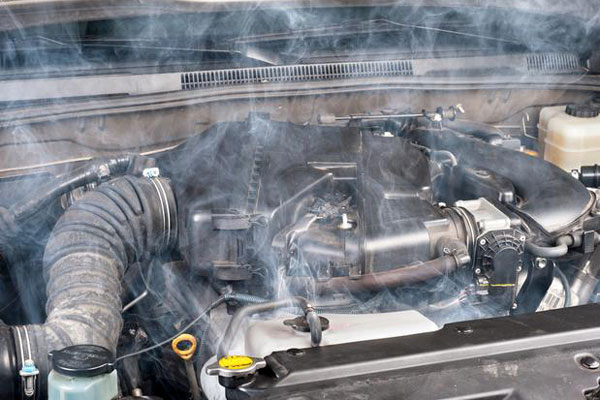
All internal combustion engines are prone to overheating. This is due to the fact that their work is associated with a high temperature regime.
The fact is that in order to lower the piston to the bottom dead center, a very large amount of energy is needed, which cannot occur without the release of a large amount of heat. As you know, metal is a material that is very sensitive to a wide range of temperature changes. When the metal is heated, it expands, respectively, in the engine there is a deformation of those areas in which compliance with the exact dimensions is the key successful work power plant.
In order not to disturb the operation of the motor, a cooling system is provided, the purpose of which is to ensure the most optimal operating temperature of the engine, at which deformation of important parts does not occur.
Optimum operating temperature for injection, carburetor and diesel engines

All drivers know that the operating temperature of the carburetor and injection engine is about 90 degrees Celsius. For a diesel engine, this value can vary from 80 to 90 degrees Celsius.
After starting the engine and during the further operation of the car, it is very important to control the work all the time. The driver must know that during the operation of the motor, it must be at a strictly specified level and not have deviations. Any deviations from the norm can tell you about a malfunction of any system (mainly cooling).
The consequences of overheating and hypothermia of the engine
- Overheat

To begin with, we will try to talk about the dangers of overheating the motor. First of all, an increase in temperature leads to intense boiling and evaporation of the coolant. As soon as the liquid is completely out of the system, the cooling will stop and then the engine temperature will rise much faster. Overheating of the engine leads to a change in the properties of the metal and to its expansion. Parts begin to deform and change their normal dimensions. All this leads to their jamming and, ultimately, it will become impossible to revive the motor without costly repairs.
Currently, all vehicles with gasoline engine have a dangerous engine temperature, which is 130 degrees Celsius. When the temperature reaches this mark, the engine jams.
The maximum allowable temperatures are limited by the properties of the coolant. If the boiling point of water is 100 degrees, then it can vary from 108 to 138 degrees Celsius. Therefore, there are a number of engines that can be operated at 120 degrees.
Video - Main road - what causes engine overheating
- hypothermia
No matter how strange it may sound, but engine hypothermia can also be. It's about about cars operated in areas extreme north where sub-zero weather is a daily occurrence. The overcooling of the engine occurs mainly during the movement of the car, when the flow of cold air blows the radiator and the motor itself at a rapid speed. First of all, the coolant reaches a low temperature very quickly, which cools the engine at a rapid speed even during operation under heavy loads.
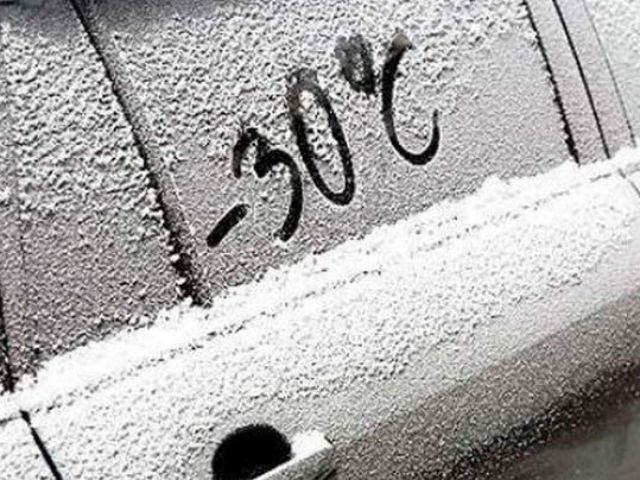
A low engine temperature can lead to the following troubles:
- For a carbureted engine - freezing of the engine power system. In this case, the jet through which air must flow is very quickly covered with ice, and the car's candles are simply flooded. In this case, it is impossible to continue moving until the candles dry out. This problem is solved by installing a special corrugation on the air filter, which collects a stream of warm air near the engine exhaust manifold.
- Coolant freezing. Basically, this problem concerns cars operated on water. The fact is that during normal operation during the cold period, the temperature drops to such values that the thermostat closes the water supply to the radiator. Accordingly, when driving, the water in the radiator freezes and when the engine reaches increased loads, even with an open thermostat, it does not circulate through the radiator, respectively, the engine starts to overheat. This is how hypothermia can lead to overheating. To prevent this, a partition made of thick fabric or blinds is hung on the radiator grille.
- Hypothermia can lead to bad job interior heating systems, which is so important for ensuring the normal functioning of a person in a car. Since the coolant cools down, the air entering the car interior also cools down, respectively, driving a car begins to bear some discomfort.
This is how the operating temperature of the engine is responsible for many processes occurring in various systems of the internal combustion engine. Try to pay increased attention to this parameter as often as possible, since the life of your motor depends on it.
As soon as the internal combustion engine starts to work, chemical processes take place in it at temperatures equal to several hundred degrees. To compensate for constant overheating, a cooling system operates in cars, based on the circulation between the radiator and the engine of antifreeze or antifreeze. Inevitably, the liquid heats up, but with excessive heating, it rapidly loses its properties and begins to boil. Today we will find out what a normal coolant temperature can and should be, and explain why it is so important to monitor this indicator.
First signs
In principle, the operation of the cooling system, along with most of the engine components, remains invisible to the driver's eye. But this statement is true exactly as long as the system is working properly and in the mode that is considered normal. As soon as the cooling is no longer carried out properly, the driver will certainly understand that something has gone wrong.
How exactly? Firstly, the device, which is located next to the speedometer and is responsible for displaying the operating temperature, will display the arrow on the red scale. On some models, if the temperature is too high, a special warning lamp will light up to alert the driver to take urgent action.
Of course, the degree of such overheating varies. With a relatively small excess of the temperature threshold, for example, absolutely nothing will be said about the problem, except for the not quite usual indicators of the operating temperature indicator. True, at the same time, a slight drop in power and peculiar dips during acceleration and increase in speed can be felt.
But with significant overheating, thick White smoke from under the hood. This is clear evidence that the antifreeze or antifreeze has boiled, and its vapors are actively emitted, producing the evaporation of liquid from the motor and radiator. In this case, it is extremely important not to turn off the engine, but to let it work for idling, and only after the temperature drops a little, turn off the ignition.
accepted norm
Generally speaking, the operating temperature does not need to remain constant. When the engine is turned off and the car has stood still for at least a few hours, the antifreeze has warmed up to about room temperature. Such an indicator is not the norm, and therefore it is necessary to warm up before moving the internal combustion engine.
How to understand that the motor has fully accepted working condition and ready to move on? This, of course, is evidenced by the device, which has a small pictogram with a thermometer at the bottom of the scale. The marking of its scale, as a rule, varies from 50 to 130 degrees - this interval, with some margin in both directions, centers around the normal temperature indicator. The norm, by the way, is 90 degrees - this is equally true for cars, trucks and any other types of vehicles.
It is quite possible that it will turn out that even after a long movement the temperature has not become normal, but is, say, 60-80 degrees. This can happen for two reasons. The first of them - the device or temperature sensor is faulty, so their readings simply do not match the real ones. The problem, as a rule, is solved by diagnostics from the masters and the replacement of inexpensive and rather primitive functional elements and sensors.
The second reason is a strong cold, which does not allow a running motor to warm up to the desired temperatures. The fact is that the coolant constantly circulates from the internal combustion engine to the radiator, and this process does not stop during operation. In this regard, in some cases, even when the fan is off, the antifreeze remains insufficiently heated, and the motor does not reach the required temperatures.

The main task of the cooling system is to cool the engine. More precisely, to maintain the optimum temperature of a running engine, which is 90-110 ° C. The main working element of the cooling system is antifreeze or antifreeze.
This liquid is poured into the car radiator. Coolant, unlike water, does not freeze at temperatures down to -40°C -65°C, but boils at temperatures above + 108°C. The fluid also has lubricating and anti-corrosion properties. regular inspection, especially in the off-season - before summer and winter.
Since the coolant (coolant) has such great importance, then it attracts special attention from drivers. Questions are often asked about the quality of the coolant, its properties and use. We will try to answer some of these questions now, some in other articles on our website.
Watch a video about changing the coolant
What to do if the coolant has changed colors
The coolants sold in the distribution network have different colors, depending on the dye added there. They have no effect on the properties of the liquid itself. And they are, rather, the quirks of the manufacturer. Well, and, to some extent, they help car owners not to make a mistake and not mix coolants from different manufacturers.If during use the liquid has changed color and acquired a reddish-brown, rusty tint - this is a signal for an urgent replacement of antifreeze (antifreeze). The liquid in this state takes on not only an aggressive appearance, but also destroys the cooling system from the inside.
If the coolant has turned red, it is possible that the engine is already overheated.
Therefore, it is imperative to inspect the engine, check its condition and find out if repairs are needed.
What should be the coolant for the engine
In Russia, antifreezes are produced in accordance with the requirements established by GOST 28084-89. The standard defines the main indicators of coolant: appearance, the temperature of the beginning of crystallization, density, foaming, corrosive effect on metals, swelling of rubber, and the like.Foreign-made antifreezes are determined by the AST M or SAE standard, which regulate the properties of antifreezes and concentrates and the conditions for their operation. Purpose of liquids:
- ASTM D 3306 and ASTM D 4656 - for small trucks and cars;
- ASTM D 4985 and ASTM D 5345 - for off-road vehicles, large trucks;
- ASTM D 3306 is used for domestic passenger cars.
Coolants are not subject to mandatory certification.
When choosing a coolant, you should strictly follow the manufacturer's instructions and the recommendations of car manufacturers.
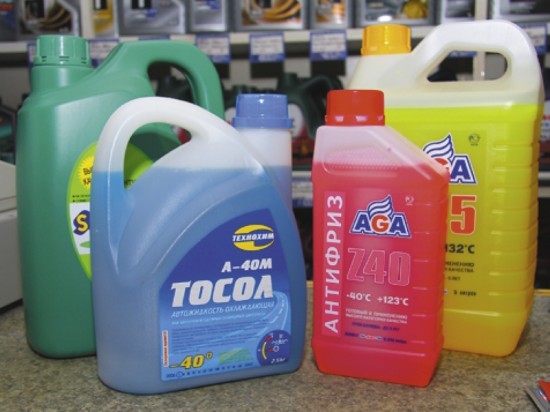
Antifreeze, Antifreeze or something else - everyone chooses for himself
Are coolants compatible?
This can be determined by the specifications. Manufactured according to different specifications liquids are usually incompatible, as they contain additives that can react and change their properties. If necessary, add coolant, it is better to add distilled water.What are the consequences if the coolant is above the level
The coolant level in the expansion tank should be checked regularly and stay between the LOW and FULL marks on the reservoir stack. The volume, and hence the coolant level, changes depending on its temperature, therefore, when the engine is warm, it should be at the level of the FULL mark, and in a cold state - only slightly above the LOW mark.If the previously normal level rose sharply, then there was an excess pressure that forced the antifreeze into the tank. The most common cause of this is air getting into the system or if the radiator cap is not holding pressure. Gases in the coolant prevent its normal circulation through the cooling system. cause the engine to overheat. Subsequently, an overheated motor may require quite a significant repair.
What is the maximum coolant temperature for cars
The antifreeze temperature control sensor detects changes in engine temperature and signals the Electronic Control Unit (ECU) about the current state of the engine.The boiling point of coolant-40 at atmospheric pressure is not less than 108°C. Coolant OZH-65 boils at atmospheric pressure at a temperature of more than 110°C.
Before boiling, the formation of vapor locks already occurs, disrupting the normal operation of the cooling system. This may cause the engine to overheat. When operating the machine in urban traffic jams, sandy roads, mud, snow, antifreeze with a higher boiling point is desirable.
The expansion tank has two valves (inlet and outlet). The exhaust valve opens at a pressure of 120 kPa and prevents intense vaporization. The cooled liquid decreases in volume and a vacuum occurs in the system. The inlet valve opens at a pressure of 3 kPa. Serviceable plug valves are important to ensure the normal operation of the entire cooling system.
A malfunctioning exhaust valve is fraught with a decrease in the boiling point of the coolant, and a stuck closed one can cause an emergency increase in pressure and damage to the hoses and radiator.
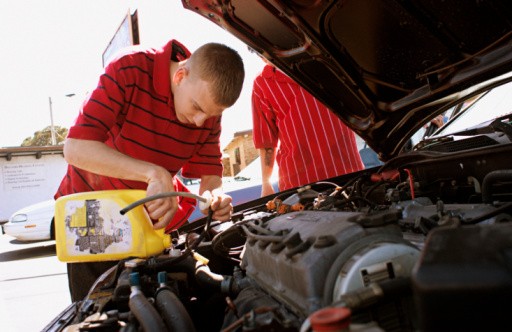
How many degrees should the coolant be
The normal temperature of a running engine is 80-90°C. Upon reaching a temperature of 100 ° C? liquid starts to boil. In this case, immediately turn off the engine and stop the car. Otherwise, the motor may be damaged and will require major repairs.During the engine start, when it has not yet warmed up, the thermostat is completely closed, the liquid circulates only in a small circle. As the engine temperature rises, the thermostat opens slightly, part of the fluid goes in a large circle, the rest continues to move in a small circle. When the coolant reaches a temperature of 80-90 ° C, the thermostat opens completely and all the coolant goes into a large circle.
If the engine becomes too cold during operation, the thermostat closes completely or partially again, redirecting the liquid or part of it to a small circle. Thus, the normal operating temperature of the engine is maintained.
How aggressive coolant manifests itself
Currently, the most widely used low-freezing liquids are glycol-based (a mixture of water and ethylene glycol). Sometimes you can find liquids with a base of propylene glycol.Properties and composition of antifreeze
Ethylene glycol is an odorless oily liquid with a crystallization temperature of -11.5°C and a boiling point of 197°C. Aqueous solutions of ethylene glycol are chemically aggressive and cause corrosion of steel, aluminum, cast iron, brass and copper parts of the cooling system, solders that are used to solder its components. Ethylene glycol is highly toxic.Propylene glycol - has properties similar to ethylene glycol, it is not as toxic and more expensive. In different concentrations, solutions have a crystallization temperature from 0 to -75°C.
Any coolant is more or less aggressive and interacts with rubber, aluminum and cast iron. This process is even more intensive when using cheap low-quality fakes.
Reasonable reasoning about the aggressive properties of coolants is possible only after long and laborious tests for interaction with materials. The results of the research will make it possible to judge the consumer quality as corrosiveness.
It is also necessary to establish the compatibility of the coolant with each other by special studies. Such studies can be carried out at a specialized testing laboratory. The results of such work are displayed on the labels in the form of recommendations for the use and mixing of various brands of coolant.
What to do if the coolant does not circulate well
The cooling system is based on the movement of the coolant, and this movement is provided by the pump. He pumps antifreeze into the water jacket of the motor. The liquid moves through the hoses, enters the radiator, cools there and is supplied again. In some car models, the cooling system is arranged somewhat differently, but the main feature remains the same.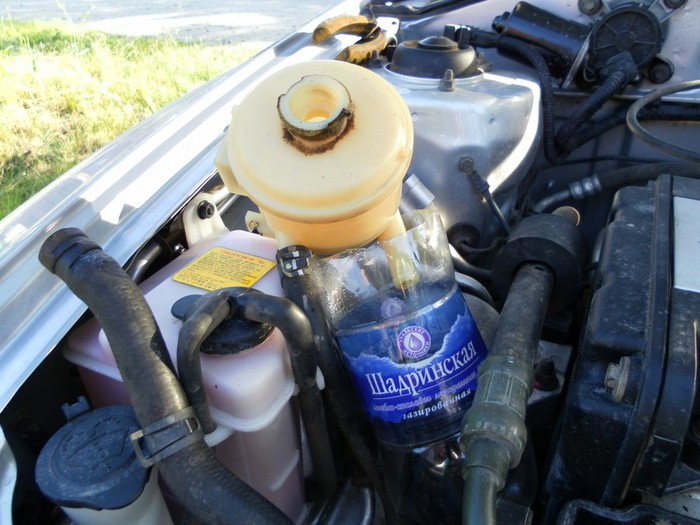
It is better not to engage in such amateur performances - it will end badly
The thermostat limits fluid circulation until the motor reaches operating temperature. It is installed on the coolant path to the radiator and opens or closes the path depending on the temperature. The thermostat maintains a certain pressure in the pump, preventing the supply of air from outside.
Air entering the cooling system leads to poor heat conduction, local overheating of the head gasket.
Search for problems and their causes
If problems associated with the cooling system are found, then it is better to determine the cause by moving from simpler to more complex:- Smudges and leakage of antifreeze. It is necessary to check the coolant level in the system visually, or by the coolant level indicator. If there is an antifreeze leak, then you need to inspect the engine compartment to detect leaks. Usually the cause of antifreeze leakage is old clamps, a broken radiator or a worn heater radiator.
- Check the circulation of antifreeze in the SOD: open the cap in the expansion tank and follow how the liquid trickle enters. The cause of poor coolant circulation can be a clogged SOD, a pump malfunction.
If the engine overheats
When the engine overheats, it is better to search for a breakdown in the following order:- Check thermostat. Touch the upper and lower radiator hoses with your hand. If the lower one is cold and the upper one is hot and the radiator is slightly warm, then the thermostat is jammed and the antifreeze circulates in a small circle. If the thermostat is stuck and in the open position, the engine does not warm up to operating temperature.
- Another cause of overheating of the motor can be an air-cooled cooling system.
Coolant enters the engine after overheating
During engine operation, the cooling system maintains the desired temperature. Violations of its work can lead to overheating of the motor. If this moment is missed, unpleasant consequences arise: a breakdown of the head gasket is possible, warping of the head, which will require a complex one. There is a coolant temperature gauge on the dashboard of the car. If the engine is overheated, the pointer needle is in the red zone.The reason for the unstable operation of the engine or its stop for Idling antifreeze can get into. Such a malfunction is not common and occurs due to a breakdown of the gasket between the cylinder block and the head or their loose fit.
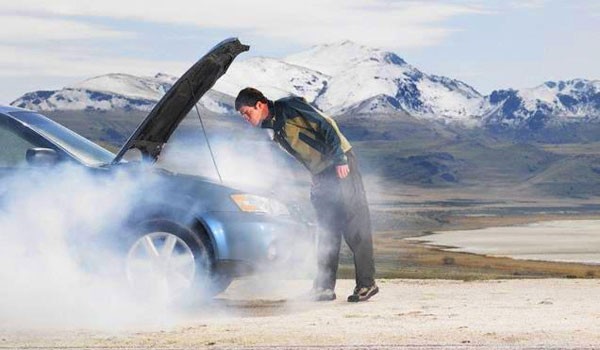
Engine overheating - the result of improper operation of the cooling system
A characteristic sign of gases entering the cooling jacket is the appearance of bubbles in the coolant, which are visible when opened. expansion tank or radiator caps. Leakage of gas to the outside can be detected by the bubbles at the gasket, if the edges of the gasket are smeared with liquid soap. The fact that coolant entered the cylinders through the gasket can be verified by moisture on the candle, or by the temperature of the candle. The cylinder spark plug feels much colder than normal when it gets on it.
These are some of the most frequently asked questions about the operation of a car's cooling system. If readers have other difficulties, or you can add something to what has already been said, you can leave your opinion in the comments. This will be of interest to both the administration and site visitors.
Are you interested in the question, what is the operating temperature of the engine? What does it depend on and how is it regulated? As it turns out, the temperature of the power unit, only to a small extent depends on the ambient temperature. The main parameters of the impact: the design of the motor and its operating conditions.
The design design includes: the method of the cooling system, its design, the heat-removing fluid used, the material from which the motor is made, the design concept of heat transfer and heat removal from the combustion chamber to the coolant fluid, the operation of the power unit, inflating in the engine, ignition, engine speed, depreciation of mechanisms. As you can see, there are a lot of factors that affect engine temperature.
Increased engine temperature can lead to various unpleasant moments. Therefore, the cooling system is used to lower the engine temperature.
Optimal temperature.
Consequences of overheating and hypothermia
Engine operating temperature depends directly. The engine cooling system is a complete set of all mechanisms and devices that performs the functions of supplying liquid to cool the engine, and then directly removing the coolant and removing heat from it through convection into the atmosphere.
The purpose of this system is to provide the most favorable conditions for the operation of the engine and in order to maintain them during the entire operation of the machine. The temperature reached at the time of combustion of the air-fuel mixture is in the order of 2000°C. The cooling system capitally reduces this temperature to the optimum value. at 80-90°C.

When the engine overheats, the mechanisms begin to experience enormous loads.
In this case, there is an increased wear of mechanisms, degradation of the lubricant, and as a result, scuffing on the surfaces of parts with further seizing and jamming. Also, when the engine temperature is high, its power is significantly reduced. In particular, this is due to poor combustion conditions and detonation of the air-fuel mixture.
The second option extremes is excessive cooling of the motor. With excessive cooling, the injected mixture begins to accumulate on the walls of the sleeves in the form of condensate.
After condensation, it seeps into the crankcase and engine sump, where it dissolves the lubricant and, accordingly, worsens the lubrication characteristics of the mechanisms.
With a poor lubricating effect, friction increases and, as a result, all this leads to wear of parts. It also leads to an increase in fuel consumption and a decrease in the efficiency of the power unit. In this regard, the correct operation of the cooling system is an integral part of the overall process of engine operation.
Related articles:
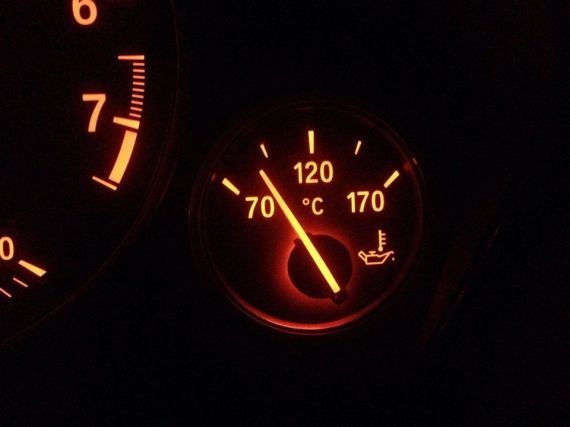
Cooling systems
Internal combustion engines require constant cooling effect of the cylinders. Only a few of them, those with low power, are cooled by the air flow. To increase the degree of cooling, special ribs are made on the cylinder liners, which increase the heat transfer surface.
When powerful, water is used for cooling, circulating under the action of a pump and cooled in a radiator under the influence of a fan and oncoming air flow. Now we will describe a little the main types of cooling.
Airflow cooling
by the most simple method cooling of the power unit is an air system. With this convection between the air and the upper finned part of the cylinder, a significant part of the heat is removed. However, this system has not found wide distribution. It is mainly used on low power motors.
Installations of this type include:
- motorcycles;
- mopeds;
- chainsaws;
- lawn mowers.
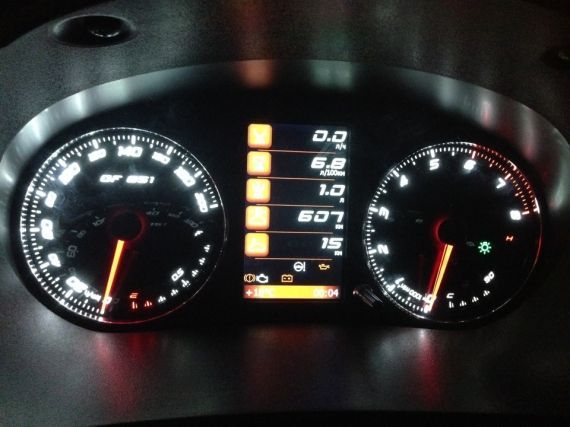
Liquid cooling: In this cooling method, the cylinder liners are flushed with water, thereby removing a significant portion of the heat. After passing the circle, the liquid returns to the container.
Liquid type cooling has long been morally obsolete, and now it is practically not found anywhere. The reason lies in its inefficiency. The water heated by the motor in the tank does not have time to cool down, and goes to the next lap. Through untimely cooling, water absorbed less and less heat with each circle.
Cooling with a hybrid system
This system includes both liquid and air. When combining the systems, it was possible to achieve a significant cooling effect. The engine itself is cooled directly by the fluid flow. After going around the entire circle, it enters the system of radiator tubes, where it is quickly cooled by air flow, and it is created using a fan.
The entire cooling system consists of: water jacket in the engine, may include several radiators, a thermostat, a fan, a pump, a tank, a tubular line and a temperature sensor. This type of cooling is found on all modern machines. The thermostat is just designed to regulate the temperature.
As a rule, it is set to maintain an optimum temperature of 80-90°C.
The most dangerous moment that can be encountered in modern system cooling is the boiling of a liquid. Huge pressure is created in the system, which significantly increases the boiling point of the liquid, so when opening the plug of a boiled radiator, take care of your hands and face. Thus, the operating temperature of the engine is constantly dependent on the correct operation of the cooling system.
If problems occur in this system, serious problems can begin with power unit. To avoid the problem of liquid boiling, special cooling liquids have been developed that have a high boiling point.




